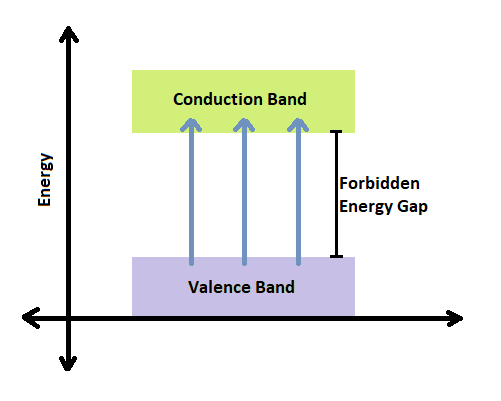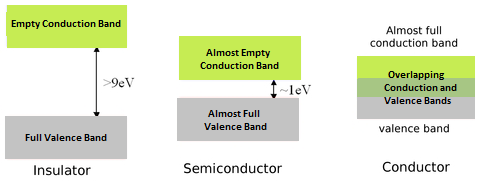
The forbidden energy gap can be overcome on thermal agitation by light. The substance is
(A) An insulator
(B) A conductor
(C) A semiconductor
(D) A superconductor
Answer
124.8k+ views
Hint: In conductors and superconductors, the conduction and valence bands are overlapped, so there is already no forbidden energy gap. In insulators, the forbidden energy gap is too large to be overcome by thermal excitation. In semiconductors, the forbidden energy gap is moderate and can be overcome.
Complete step by step solution:
First of all, we need to have a clear idea of what the forbidden energy gap is.

The forbidden energy band gap is the energy difference between valence band and conduction band of a substance. As the name suggests, this energy region is forbidden, that is, no electron occupies this state. This gap between valence band and conduction band, also determines the classification on the basis of electrical conductivity of a material. On the basis of electrical conductivity, materials are categorized into three main types:
Insulators: Forbidden energy gap > 9eV
Semiconductors: Forbidden energy gap ≈ 1eV
Conductors: Forbidden energy gap < 1eV
The forbidden energy band gap for all three types is shown:

Therefore, in semiconductors, the forbidden energy gap is small and can be overcome by thermal agitation, that is, by increasing temperature, unlike insulators. So, as the temperature of the semiconductor is increased, the forbidden energy gap tends to decrease.
Option (C) is correct.
Note: There is also an explicit temperature dependence of the forbidden energy gap which can be mathematically expressed from the following relation: \[{E_g}(T) = {E_g}(0) - \dfrac{{\alpha {T^2}}}{{T + \beta }}\]
where, \[{E_g}(T)\] is the forbidden energy gap at absolute temperature T
\[{E_g}(0)\] is the intrinsic forbidden energy gap
\[\alpha \] and \[\beta \] are constants.
So, we can see the decrease in the forbidden energy gap on increasing temperature mathematically as well as theoretically. Hence, the forbidden energy gap can be overcome by thermal agitation in semiconductors but not in insulators.
Complete step by step solution:
First of all, we need to have a clear idea of what the forbidden energy gap is.

The forbidden energy band gap is the energy difference between valence band and conduction band of a substance. As the name suggests, this energy region is forbidden, that is, no electron occupies this state. This gap between valence band and conduction band, also determines the classification on the basis of electrical conductivity of a material. On the basis of electrical conductivity, materials are categorized into three main types:
Insulators: Forbidden energy gap > 9eV
Semiconductors: Forbidden energy gap ≈ 1eV
Conductors: Forbidden energy gap < 1eV
The forbidden energy band gap for all three types is shown:

Therefore, in semiconductors, the forbidden energy gap is small and can be overcome by thermal agitation, that is, by increasing temperature, unlike insulators. So, as the temperature of the semiconductor is increased, the forbidden energy gap tends to decrease.
Option (C) is correct.
Note: There is also an explicit temperature dependence of the forbidden energy gap which can be mathematically expressed from the following relation: \[{E_g}(T) = {E_g}(0) - \dfrac{{\alpha {T^2}}}{{T + \beta }}\]
where, \[{E_g}(T)\] is the forbidden energy gap at absolute temperature T
\[{E_g}(0)\] is the intrinsic forbidden energy gap
\[\alpha \] and \[\beta \] are constants.
So, we can see the decrease in the forbidden energy gap on increasing temperature mathematically as well as theoretically. Hence, the forbidden energy gap can be overcome by thermal agitation in semiconductors but not in insulators.
Recently Updated Pages
JEE Main 2021 July 20 Shift 2 Question Paper with Answer Key

JEE Atomic Structure and Chemical Bonding important Concepts and Tips

JEE Amino Acids and Peptides Important Concepts and Tips for Exam Preparation

JEE Main 2023 (April 8th Shift 2) Physics Question Paper with Answer Key

JEE Main 2023 (January 30th Shift 2) Maths Question Paper with Answer Key

JEE Main 2022 (July 25th Shift 2) Physics Question Paper with Answer Key

Trending doubts
JEE Main 2025 Session 2: Application Form (Out), Exam Dates (Released), Eligibility & More

JEE Main Exam Marking Scheme: Detailed Breakdown of Marks and Negative Marking

The formula of the kinetic mass of a photon is Where class 12 physics JEE_Main

JEE Main 2023 January 24 Shift 2 Question Paper with Answer Keys & Solutions

Learn About Angle Of Deviation In Prism: JEE Main Physics 2025

JEE Main 2025: Conversion of Galvanometer Into Ammeter And Voltmeter in Physics

Other Pages
JEE Advanced Marks vs Ranks 2025: Understanding Category-wise Qualifying Marks and Previous Year Cut-offs

JEE Main Login 2045: Step-by-Step Instructions and Details

Dual Nature of Radiation and Matter Class 12 Notes: CBSE Physics Chapter 11

Electric field due to uniformly charged sphere class 12 physics JEE_Main

Ideal and Non-Ideal Solutions Raoult's Law - JEE

JEE Mains 2025 Correction Window Date (Out) – Check Procedure and Fees Here!




